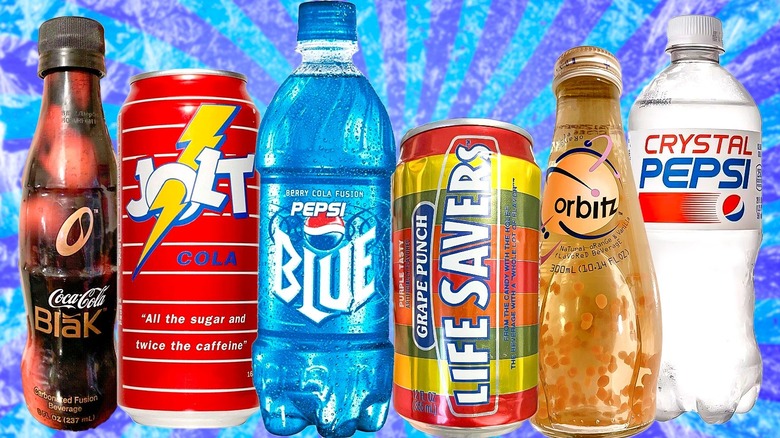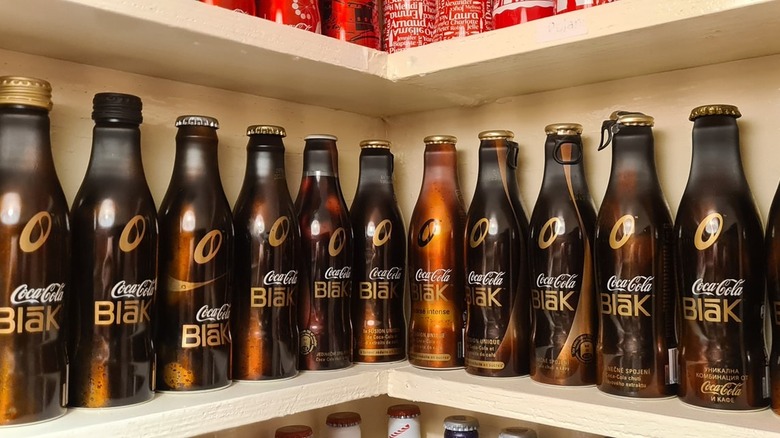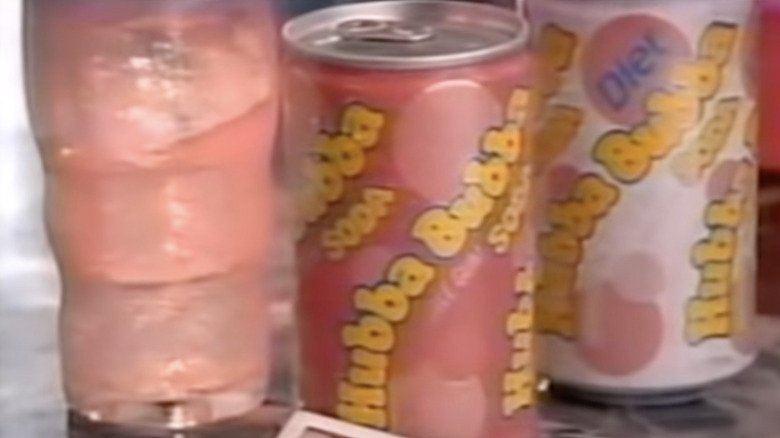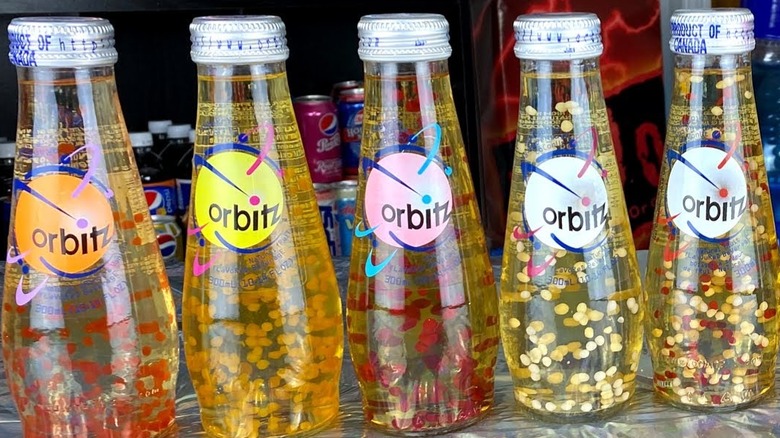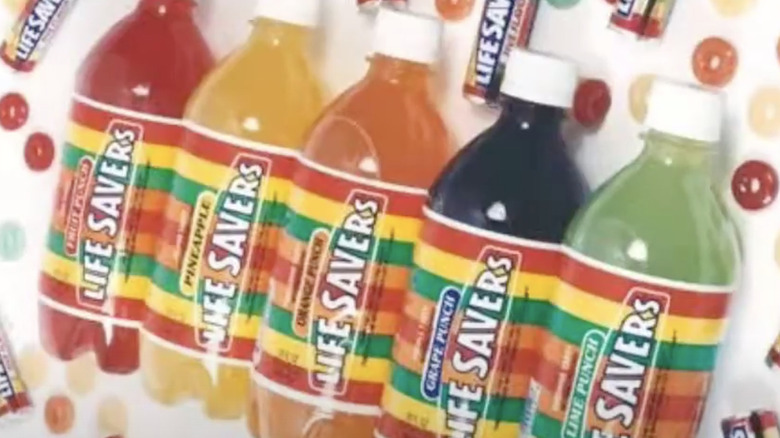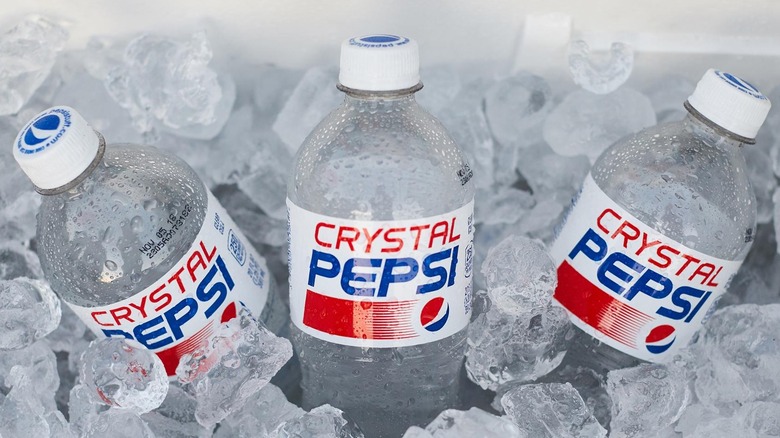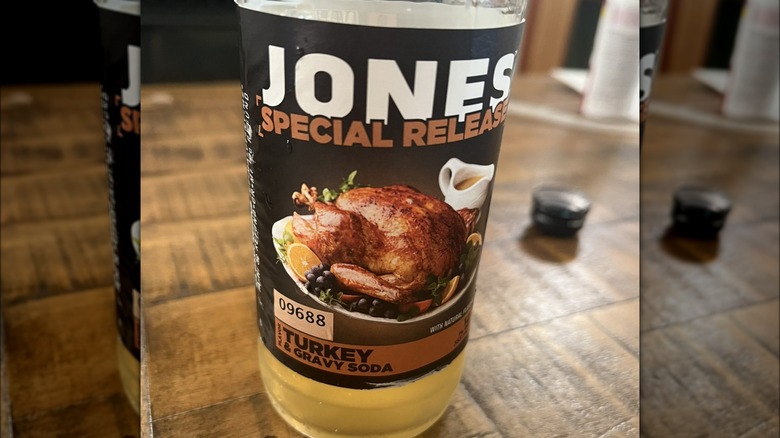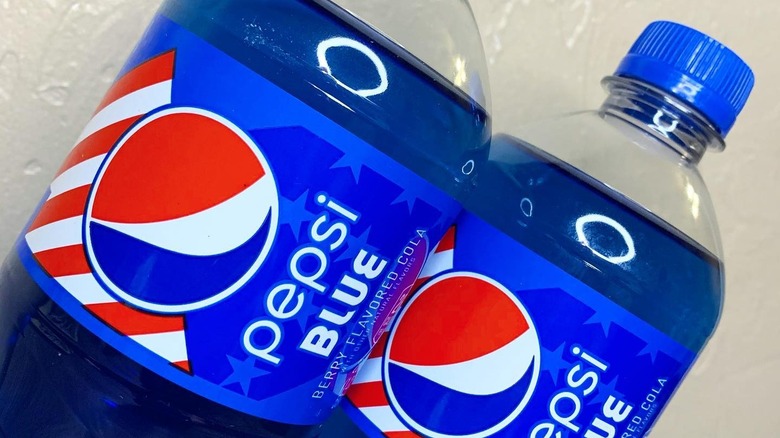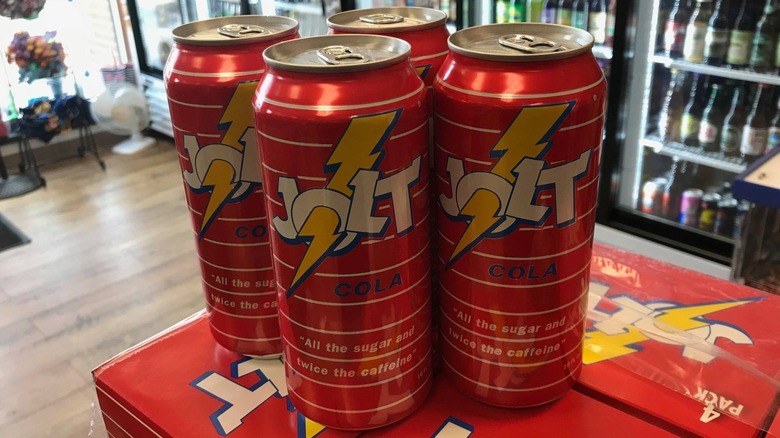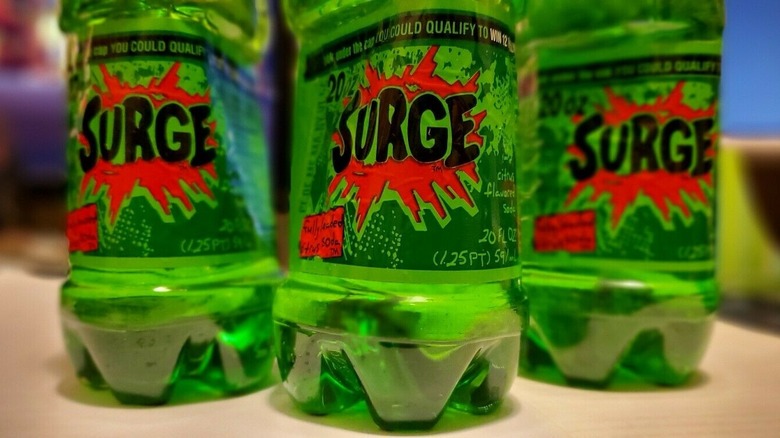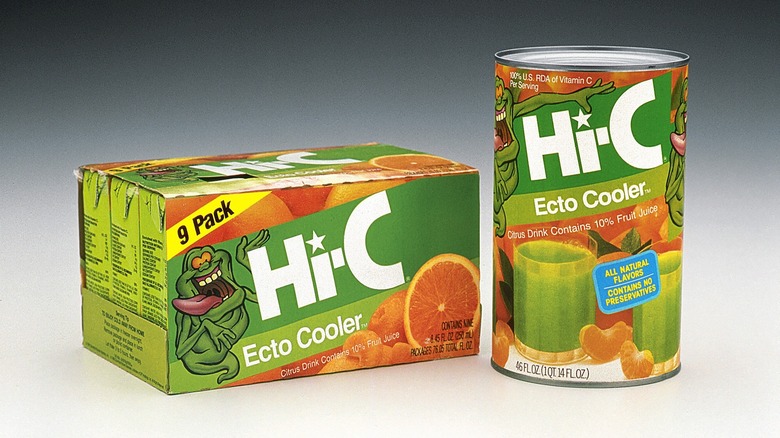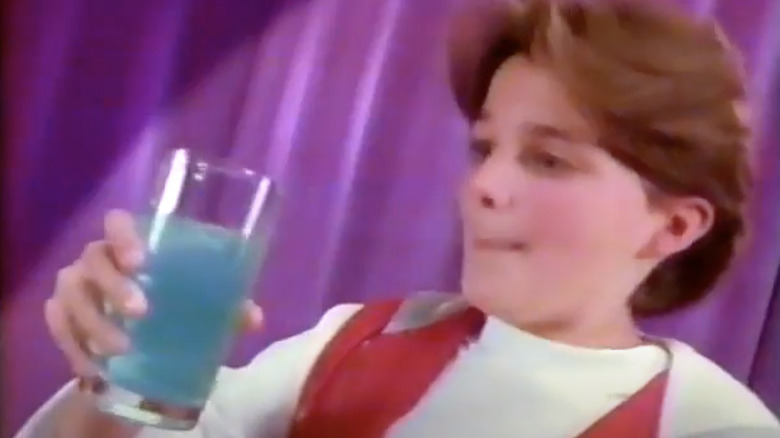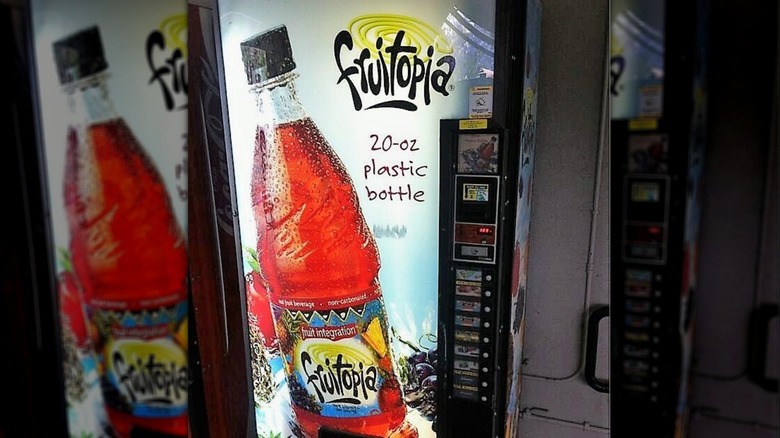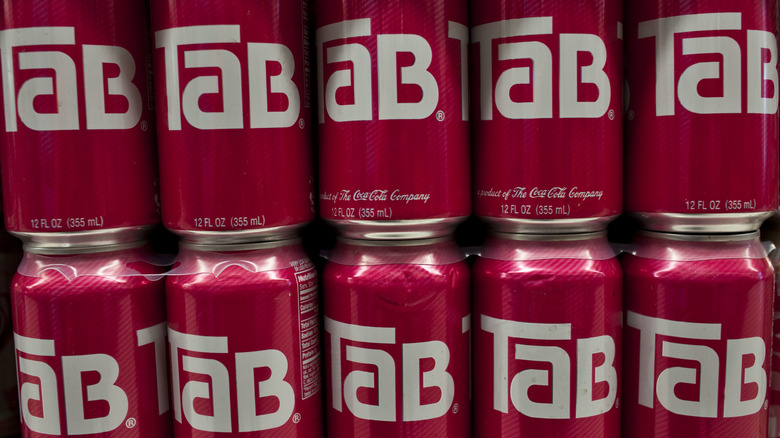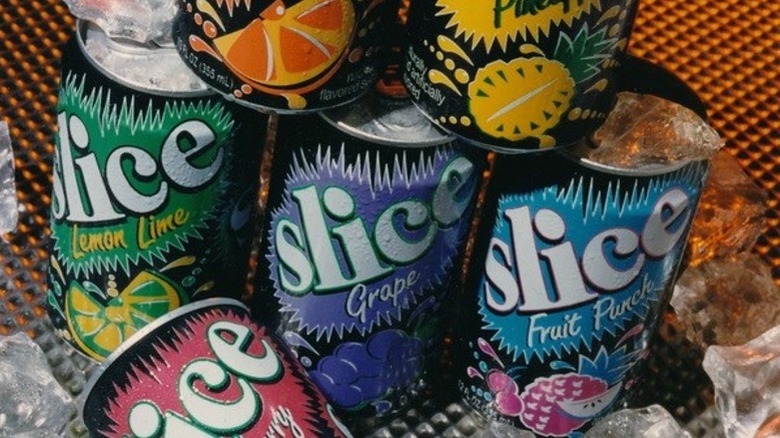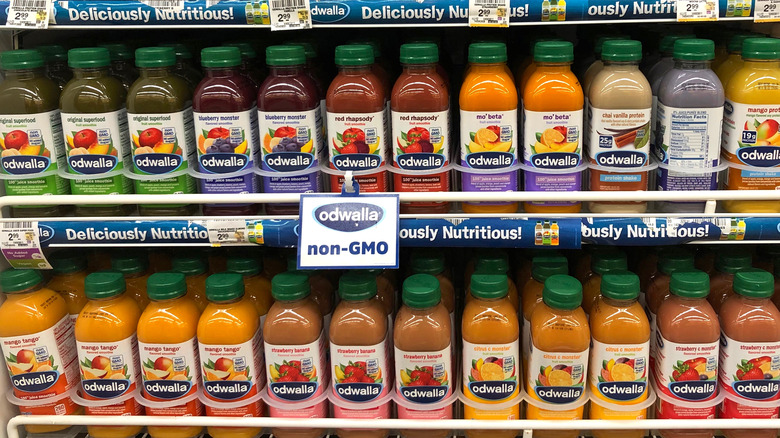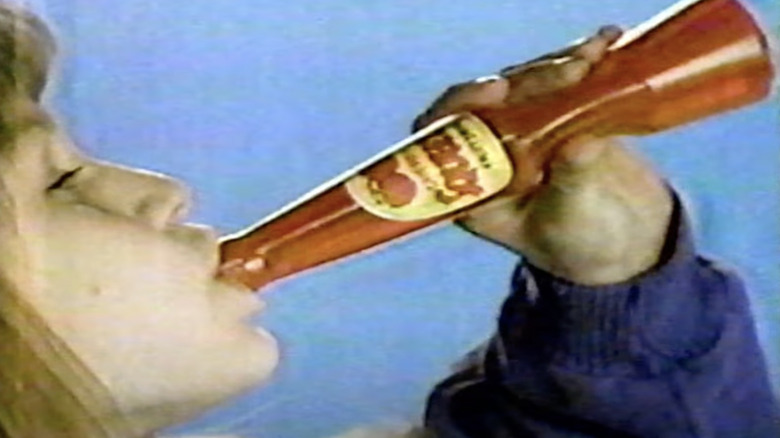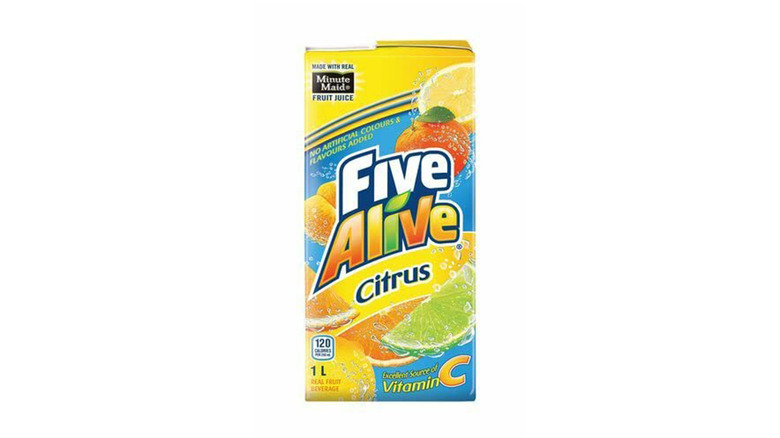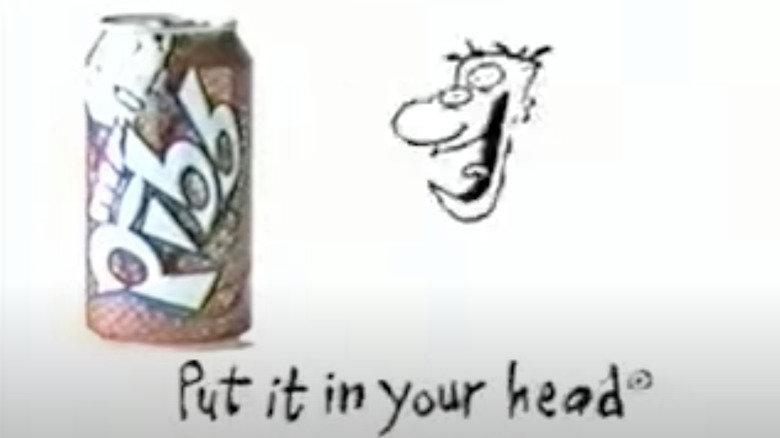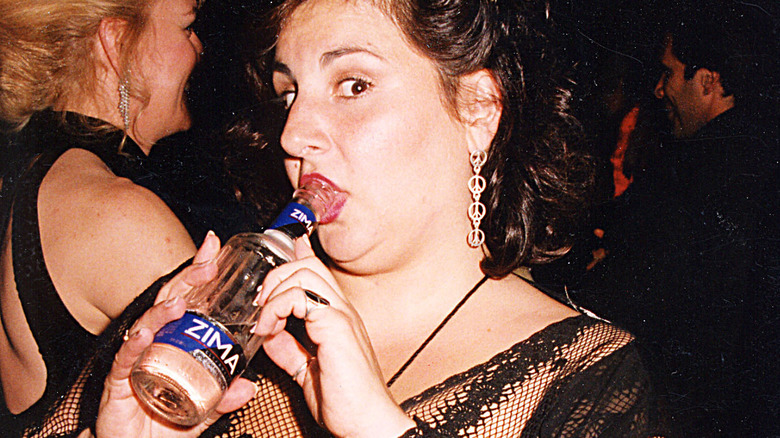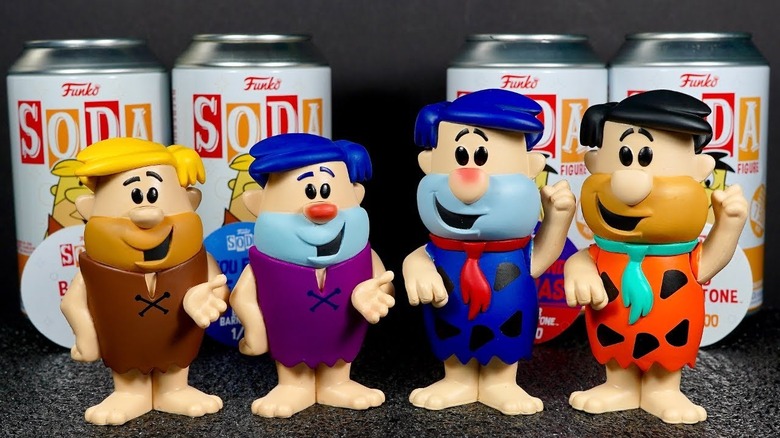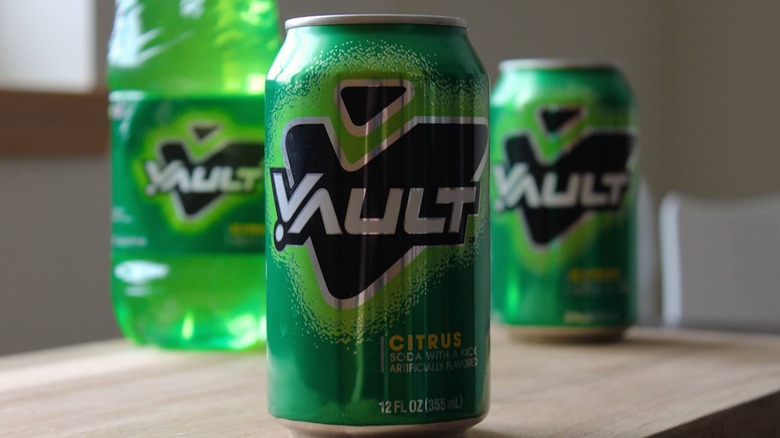21 Popular Drinks That Have Disappeared From Store Shelves
We may receive a commission on purchases made from links.
Great beverages can leave a lasting impression. Beyond quenching your thirst (and potentially satisfying your sweet tooth), a tasty drink can remind you of a special time in your life. The feeling of flavored bubbles popping against your tongue or the sweet rush of juice flowing into your mouth is a distinct experience, after all. But with a seemingly endless variety of beverages on the market, brands are often introducing new flavors — and discontinuing products — to stay competitive in a market with constantly changing trends.
Of course, when a popular drink is discontinued or pulled from stores, it often causes an uproar among that drink's dedicated (if niche) following. While some brands have been fortunate to see a return to store shelves — thanks to a loyal enough fanbase and rigorous petitioning — most are relegated to resell sites or specialty soda retailers. In honor of those bygone beverages, we've compiled a list of popular drinks your local grocery store no longer carries. Here are 23 popular drinks that have disappeared from store shelves.
Coca-Cola Blak
While Coca-Cola pairs nicely with many things, coffee might not be the first one that comes to mind. Yet when Coca-Cola Blak hit stores in 2006, the potential allure of a Coke and coffee mash-up was too good for the soda company to pass on. Given it contained twice the caffeine of a regular Coke, it was expected to be a big hit. However, the beverage failed to jolt Coke's fanbase, and it disappeared from store shelves in a mere 16 months.
There are several likely reasons why Coca-Cola Blak fizzled out, including its off-brand packaging and niche marketing strategy. The experimental and energizing drink was rumored to have an unusual taste, as well, with a creamy coffee consistency that frothed when poured.
Hubba Bubba soda
You may not remember Hubba Bubba soda given its short shelf life. After all, this pink beverage (derived from the popular bubblegum) was released in 1988, but was discontinued in less than 5 years. The taste was rumored to come from a bubblegum-flavored snow cone syrup invented by a fan named Steve Roeder — who secured the rights from Wrigley — rather than the actual Hubba Bubba recipe.
When Roeder blended club soda with a bubblegum-flavored syrup, he may have captured the taste of the original bubblegum – but he failed to win over the hearts of its fans. Despite Hubba Bubba releasing a diet version of its soda alongside the original flavor, this beverage simply wasn't long for this world.
Orbitz soda
Easily one of the coolest and most inventive beverages we've ever seen, Orbitz Soda is the perfect example of the wacky creativity of the '90s. It resembled a drinkable lava lamp and was filled with funny-looking floating balls made with food dye, artificial flavoring, and gelatin. Vibrant colors and mysterious chewy balls aside, though, the taste was a different experience entirely.
Unfortunately, most of the appeal of Orbitz soda came from how it looked. Although it garnered some success, the flavor was compared to cough syrup and even Pine-Sol. Consequently, the company chose to discontinue it soon after its 1996 release — although much like the drink's tiny floating spheres, you may still be able to find a decades-old bottle floating for sale online.
Life Savers soda
This is another candy-inspired soda, this drink was released in 1995 and hoped to mimic the success of the original Life Savers. From the colorful striped branding to the selection of flavors, Life Savers soda was a drinkable recreation. Fans could get their sweet fix with pineapple, fruit punch, orange punch, grape punch, or lime punch flavors.
Before release, Life Savers soda received a positive response during initial taste tests before its release. But the wider public seemingly felt differently after it reached store shelves, leading to poor sales. While there are worse things than drinking liquid life savers, the sugary marketing strategy appears to have contributed to its eventual discontinuation.
Crystal Pepsi
One of the most iconic beverage concepts ever created is Crystal Pepsi. Born in 1992, this soda was a clear-colored, caffeine-free version of the original that attempted to capitalize on the health trends of the early '90s. Of course, while capturing the classic Pepsi taste may have been the goal, the resulting sip left a different impression altogether.
Since more thought was put into marketing Crystal Pepsi than accurately mimicking the original, the flavor was more akin to a sugary seltzer. It didn't match the robustness of the O.G. and the public's negative response forced Crystal Pepsi from shelves in 1994. Despite the backlash, the drink still enjoys a loyal following to this day and even saw a brief return for the clear soda's 30th anniversary in 2022.
Jones' Thanksgiving Dinner Soda
Jones Soda is a pioneer in the craft soda space. The cane sugar-sweetened beverage carved out a niche in an oversaturated market by offering unique flavors — like the limited-edition holiday pack it released in 2004. Customers were given several seasonal flavored sodas to try, including Green Bean Casserole, Mashed Potato & Butter, Cranberry, and Turkey & Gravy.
A drinkable Thanksgiving dinner? Admittedly, the idea does sound intriguing. But food-flavored sodas are rarely tasty enough for everyday enjoyment. The schticky selection of sodas had a limited run before disappearing from shelves (though the Turkey & Gravy flavor saw a brief return in 2021 for the brand's 25th anniversary).
Pepsi Blue
Pepsi experimented with 100 different recipes to create its bright-colored Pepsi Blue flavor. First released in 2002, the soda tasted like a mix of blueberry and raspberry and seemed inspired by the success of Moutain Dew Code Red.
Despite a Britney Spears-backed promotional campaign and widespread marketing, Pepsi Blue ultimately ended up falling flat with the company's fanbase. Consequently, Pepsi Blue was discontinued after only two years on the market in 2004 (with a brief 2021 return coming and going just as quickly). This blue-hued soda may have been surprisingly successful in certain international markets. But it couldn't gain a following in the U.S. before disappearing from store shelves for good.
Jolt Cola
The energy-boosting beverage market is undeniably popular in the 21st century. But one drink helped pave the way for those beverages during the mid-1980s: Jolt Cola. The cola-flavored soda was released in 1985 to counteract the diet-centric trends that were on the rise at that time. Marketed as having "all the sugar and twice the caffeine," Jolt Cola saw some success for many years (unlike other entries on this list).
However, after experiencing financial difficulties in 2008, the brand was forced to declare bankruptcy the following year. Jolt made a brief return in 2017 at select locations, but appears to have been completely discontinued as of 2020.
SURGE
SURGE soda was an iconic '90s beverage that young folks loved in part due to its aggressive marketing. Citrus-flavored and packed with energy-boosting ingredients, SURGE certainly lived up to its name. It was released in 1997, but unlike other beverages on this list, wasn't necessarily discontinued due to low sales. Rather, Sergio Zyman — the initial head of Coca-Cola's marketing department during SURGE's launch — had a distinctly different marketing style than Charles S. Frenette, who replaced him in 1998.
Frenette's method ultimately caused Coca-Cola's (and SURGE's) stocks to decline, leading to the soda's discontinuation in 2003. In the years that followed, a loyal following worked tirelessly to bring the soda back, even going so far as to purchase a billboard near Coca-Cola headquarters. The petitioning worked — at least momentarily, as SURGE briefly returned for a limited-time in 2014.
Hi-C Ecto Cooler
Popular cinema has inspired the creation of some truly amazing products. The iconic paranormal comedy Ghostbusters was so successful after its 1984 debut that it led to the release of a drink that was nearly as beloved as the film: Hi-C Ecto Cooler. The beverage brand's Ecto Cooler was a green-colored citrus-flavored fruit drink that attempted to replicate the appearance of ectoplasm (or a substance produced by supernatural entities).
Hi-C Ecto Cooler enjoyed a good run before being discontinued in 2001 — though the drink returned briefly in conjunction with the release of "Ghostbusters: Afterlife" in 2021. Since this popular 1990s food has become a symbol of nostalgia and still commands a dedicated fanbase, we're hopeful it will return when the franchise's next sequel hits theaters.
Kool-Aid Great Bluedini
Even if you didn't know Kool-Aid began as an actual drink rather than a powder, it's clear the beverage brand has blessed the palates of consumers with countless flavors throughout its existence. Yet one Kool-Aid drink that deserves honorable mention is the Great Bluedini. Hitting store shelves around 1992, the Great Bluedini was a blue raspberry-flavored powder mix that changed colors when blended.
Its branding featured a magical octopus alongside the Kool-Aid Man (AKA the company's resident mascot). Unfortunately, beyond the gimmicky marketing, Great Bluedini was just an ordinary Kool-Aid flavor; and like many before (and after) it? It was eventually discontinued. The Great Bluedini flavor made a return to store shelves in 2014 for a brief moment before disappearing once more — seemingly forever.
Fruitopia
Fruitopia deserves its flowers as one of the best juice sodas to ever hit the market. Launched by Coke in 1994 with an enormous $30 million advertising budget, it was honored as one of TIME's 10 best new products of that year. Like SURGE, it was a brainchild of Coca-Cola's former marketing chief, Sergio Zyman, and stood out with unique flavor names like Grape Beyond and Citrus Consciousness.
Sadly, Fruitopia's fighting chance came to a screeching halt in 2003, when Coca-Cola decided to remove it from the U.S. market. While there weren't any blaring reasons why it disappeared from store shelves, it seems Fruitopia ultimately couldn't compete with Snapple and its sibling brand, Minute Maid.
TaB
TaB is another popular drink now buried deep in the vaults of discontinuation. Introduced in 1963 as Coca-Cola's first diet soda, Tab is one of the oldest products included on this list. Between its release and 1980, TaB was the premier diet soda on the market and lived happily on store shelves for 57 long years before being discontinued in 2020.
Coca-Cola cited a desire to streamline as the reason for its discontinuation. But according to consumers, it had a polarizing taste (some fans enjoyed the drink so much they stockpiled TaB in anticipation of its eventual demise). On that note, even though Diet Coke was introduced in 1982, as well — and subsequently outsold TaB — Coke kept its original diet cola around for decades thanks to an aggressively devoted fanbase.
Slice Soda
The '80s gave birth to many popular drinks, with some still having cult followings despite being discontinued long ago — like Slice soda. Loaded with a sweet lemon-lime flavor, Slice was created by PepsiCo in 1984 and contained 10% real fruit juice. That may not sound like much by today's standards, but it set Slice apart in a market saturated with artificial sweeteners.
Gimmicks aside, the soda tasted incredible, and issues only arose when the company decided to diversify its flavor selection. Eventually, Slice offered 15 fruit flavors to choose from, which muddied the brand's voice and contributed to a decline in sales and discontinuation. While the original Slice is gone as we know it, a completely different-looking Slice soda returned in 2018 with a new recipe and design (though that also appears to be gone as of February 2024).
Odwalla
Odwalla may not have been as healthy as some folks believed it to be, but the brand almost certainly helped pave the way for the emergence of real fruit juice and smoothie brands in the 21st century. The Coca-Cola-owned beverage first lined store shelves in 1980. Although it was initially an independent company, Odwalla was purchased by Coca-Cola in 2001 for $181 million.
Since Pepsi owned Gatorade and a majority stake in SoBe, Odwalla would have helped Coca-Cola compete with its line of fruit juices, tea drinks, and sports drinks. But after experiencing many years of success, consumer tastes began to shift, and Odwalla's ingredients came into question — namely, its high sugar content. As of July 31, 2020, all distribution of Odwalla ceased, and it has yet to return since its discontinuation.
Squeezits
From the zany commercials to its distinctive bottle design, Squeezits were everything a kid could ever want from a popular drink. One of many classic treats gifted to us by General Mills, it was launched in 1985 — and by the mid-1990s? The bottled juice drink had become an iconic piece of pop culture.
Squeezits bottles were made of plastic and (as the name implies) were designed to be squeezed when drinking. Along with a unique container, flavors were given quirky character names like Chuckin' Cherry and Rockin' Red Puncher. In many ways, the branding was actually better than the overly sugary juice itself. Perhaps that's why Squeezits' sales began to nosedive at the turn of the 20th century — leading to the drink's discontinuation in 2001.
Five Alive
Throughout the '80s and '90s, there was an endless number of sugary juice products on store shelves. While Sunny Delight and Tampico were two of the most recognizable, Hi-C Five Alive is an '80s beverage you probably forgot about. Marketed as a health drink, Five Alive first hit store shelves in 1981. It was created by Coca-Cola, came in a carton, and combined five citrus fruits: orange, lemon, lime, tangerine, and grapefruit.
Although it enjoyed a successful run for more than a decade, it was discontinued in the U.S. at some point during the 1990s. Since the reason for Five Alive's disappearance from store shelves was never explained, we're sure there's a handful of fans nostalgic for the taste of this long-gone fruit juice.
Mr. Pibb
Released by Coca-Cola in the '70s as direct competition for Dr. Pepper, Mr. Pibb is a similarly peppered-cherry-flavored soda. It was originally named Peppo before Dr. Pepper filed a trademark infringement lawsuit, which was how the name Mr. Pibb came into existence.
Though some might have argued Mr. Pibb tasted better than the competition, the soda was discontinued in 2001. While the company later introduced Pibb Xtra (which remains available as of 2024), the new soda used an entirely different recipe in addition to its new moniker — meaning it's merely related to the original rather than a revival of the classic Mr. Pibb. For anyone still craving the taste of the O.G., you may be able to find unopened cans or bottles for sale on certain resell sites (though we wouldn't recommend drinking it).
Zima
Along with sugary drinks, malted beverages were also popular during the '90s. Created and distributed by Coors in 1993, Zima was cool, citrus-flavored, and contained less than 5% alcohol by volume. It was a part of the "clear craze" from the early part of the decade, which was a popular advertisement fad that marketed "clear" as akin to "pure" — think Crystal Pepsi, transparent Apple desktops, and Clearly Canadian.
Taste-wise, Zima was reportedly similar to Sprite or super light beer, though many found it disgustingly unpalatable. It skyrocketed to success upon its initial release, but people stopped drinking Zima in the years that followed. Sales subsequently waned until its discontinuation in 2008. Though several reformulated versions of Zima have come back over time, it seems none have resulted in a permanent return to store shelves.
Flintstones Soda
Unless you're a fan of "The Flintstones" (or a retrophile), there's a decent chance you aren't aware of the popular drink the series inspired. Appropriately dubbed Flintstones soda, each character from the hit cartoon came with a special flavor. For instance, the titular protagonist, Fred, had a Pterodactyl Punch flavor, while his wife Wilma had the Sabertooth Orange. Though up to seven flavors were available at its peak — each given a prehistoric-style name – these novel drinks seemingly came and went with little fanfare in the '80s or '90s.
Information regarding the discontinuation and history of this soda (which some said was less than pleasant and overly sweet) is scarce. And while the soda has never returned, Funko released a limited-edition line of liquid-free "soda cans" with accompanying toys in 2020 that included Fred Flintstone (among other characters).
Vault
Adding to Coca-Cola's list of beverage concepts, Vault was a citrus-flavored soda that tasted similar to SURGE and Mello Yello. Customers were introduced to its boosting bubbliness in 2005 by a massive marketing campaign that included a Super Bowl Sunday placement. The then-new Vault was aimed at the same audience that loved Mountain Dew: youthful risk-takers who lived (or purported to live) an active lifestyle.
Despite having some success for several years, Coca-Cola decided to discontinue Vault in favor of its other brand, Mello Yello. Even if the reason Vault disappeared from store shelves is fairly straightforward, it also seemed to make a strong impression with fans before its discontinuation.
